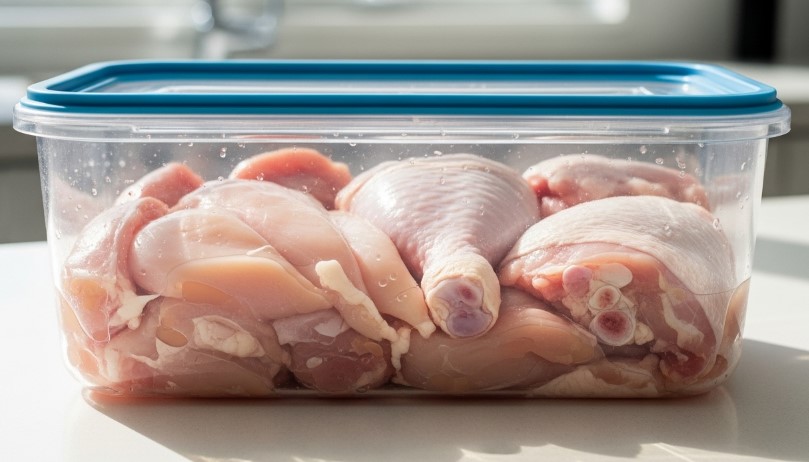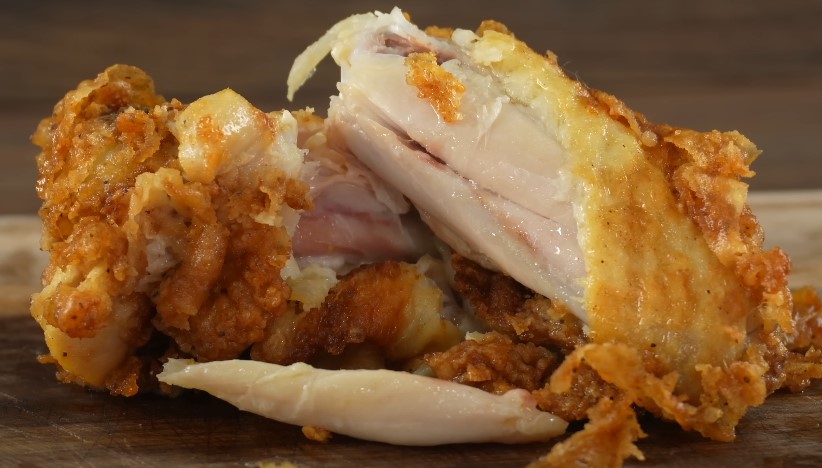If chicken has been left out overnight at room temperature, it is not safe to eat. According to USDA food safety guidelines, cooked or raw chicken should not be left out for more than two hours (or one hour if the room is above 32°C / 90°F). After that, harmful bacteria like Salmonella and Staphylococcus aureus can multiply rapidly, making the chicken unsafe even if it still smells or looks normal. Reheating won’t reliably destroy toxins that may have already developed.
So the concrete answer is simple: chicken left out overnight belongs in the trash, not on your plate.
Why Chicken Goes Bad So Quickly
Chicken is considered a high-risk food because it is highly perishable and an ideal environment for bacteria to thrive. Unlike some more forgiving foods, poultry carries a higher risk of foodborne illness.
At room temperature (roughly 20–25°C), bacteria can double in number every 20 minutes. That means a small amount of contamination can become millions of bacteria within a few hours. Overnight, the growth is so extreme that the food is no longer safe, regardless of whether you plan to reheat it.
It’s also important to understand that food safety isn’t just about bacteria — some microorganisms produce heat-stable toxins. Even if you microwave or re-cook chicken, those toxins remain and can cause food poisoning symptoms like nausea, diarrhea, or vomiting.
Smell and Appearance Can Be Misleading
Many people believe that they can “tell” if chicken is spoiled by smelling it or looking at it. Unfortunately, this is unreliable. Chicken that has been sitting out overnight may look completely fine and have little or no odor, yet still harbor dangerous levels of bacteria.
This is why food safety experts emphasize time and temperature control, not just sensory checks. If chicken has crossed that two-hour threshold (or one hour in hot conditions), it’s best to discard it.
The Food Safety Danger Zone
View this post on Instagram
Food safety guidelines often refer to the “Danger Zone”, which is the temperature range where bacteria grow fastest: 4°C (40°F) to 60°C (140°F). Any perishable food left in this range for too long becomes unsafe.
Here’s a clear breakdown:
What to Do Instead of Risking It

If you’ve left chicken out overnight, the safest choice is simple: throw it away. It might feel wasteful, but the risks of foodborne illness far outweigh the value of salvaging a meal. A single episode of food poisoning can cost you days of discomfort, medical bills, or even hospitalization in severe cases.
The good news is that there are several easy steps you can take to prevent this from happening again:
- Refrigerate promptly – Make it a habit to transfer chicken to the fridge within two hours of cooking or purchasing. This window shortens to just one hour if the room is hot (above 32°C / 90°F). Acting quickly is the most effective safeguard against bacterial growth.
- Cool large portions in shallow containers – Big dishes of roast chicken or stews retain heat for hours, staying in the “danger zone” longer. Divide leftovers into shallow containers so they cool evenly and reach a safe storage temperature faster.
- Set simple reminders – If you tend to forget food on the counter, a quick alarm on your phone or a kitchen timer can be enough to jog your memory. A gentle beep after dinner could save you from wasting tomorrow’s lunch.
- Remember the golden rule – “Two hours at room temp, one hour in heat” is a food safety mantra worth memorizing. Whenever in doubt, check the clock and follow this guideline without exception.
The Health Risks of Eating Spoiled Chicken

Chicken that has been left out too long becomes a breeding ground for harmful bacteria. Even if it looks fine and smells normal, it may be teeming with microorganisms that can cause serious illness.
- Salmonella – One of the most common foodborne pathogens linked to poultry. Infection can cause fever, stomach cramps, and diarrhea that may last for a week. In vulnerable groups, complications can be severe and even require hospitalization.
- Staphylococcus aureus – This bacterium is particularly dangerous because it produces heat-stable toxins. That means even if you reheat the chicken, the toxins remain and can cause sudden nausea, vomiting, and stomach pain within just a few hours of eating.
- Clostridium perfringens – Sometimes called the “cafeteria germ,” this bacterium thrives in cooked foods left sitting out. It often causes cramps and diarrhea that begin quickly after eating and can ruin your day, even if the illness is short-lived.
The severity of these illnesses depends on the person. Children, pregnant women, older adults, and those with weakened immune systems are at the highest risk of serious outcomes. But even healthy adults can suffer days of misery from a single mistake.
That’s why food safety experts stress that you cannot rely on sight, smell, or taste to judge whether chicken is safe. Once it has sat out overnight, the risk is too great — and no amount of reheating will make it safe again.
Final Thoughts
Chicken left out overnight is never safe to eat, no matter how tempting it may be to “just reheat it.” The two-hour rule (or one hour in hot conditions) is a hard line set by food safety authorities for good reason. Even if it looks and smells fine, bacteria and toxins may already be present in amounts that can make you sick.
The best practice is simple: when in doubt, throw it out. Protecting your health is worth far more than salvaging a forgotten meal.
Hi there, my name is Kelly Barlow and kellytoeat.com is my blog. Here, I write about various recipes I want to reccommend to readers.
I try to find the best possible recipes that can attract the attention of readers, and at the same time, I strive to write it in the most engaging manner possible.
When I was younger, I wanted to become a chef. Sadly, it wasn’t meant to be, but at the very least, I write about it.
